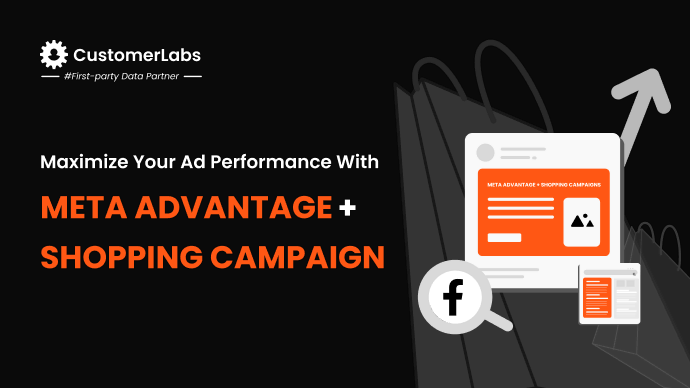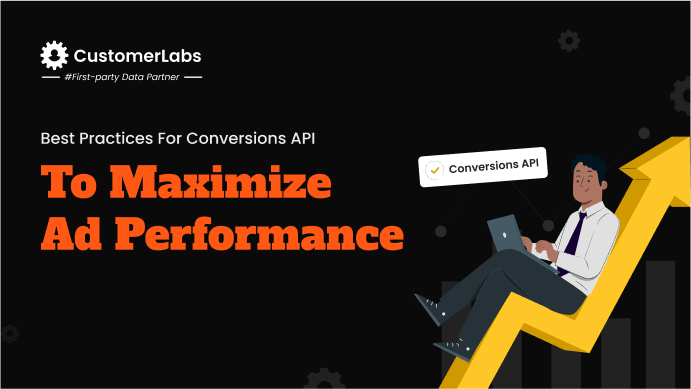It is mission-critical for every marketer to increase EMQ score, that is, the Event Match Quality score in Meta ads not only because Meta recommends it, but also due to the improved ad campaign performance seen with higher EMQ.
And, to increase the event match quality on Facebook, you need to sync event parameters with Meta. It has come to light that Meta has recently tweaked around with the priorities of these customer information parameters.
In this blog, I am gonna spill all the beans about what are all the event parameters needed for increasing your Event Match Quality.
If you’re eager to be in the loop with these latest changes and want to surge your EMQ score by sending the right parameters, keep reading!
What is Event Match Quality?
Event Match Quality is a grading system created by Meta to let marketers know how effectively it is able to match your event data with the users in its account center. In other terms, it’s nothing but how well the information you send with your events like page view, add to cart, etc, matches up with Meta accounts.
Why does EMQ matter?
The Event Match Quality matters because higher EMQ helps Meta identify the user accurately and by doing so it will be able to attribute the conversion that results from your ads. So, with an increased EMQ score, naturally, you have a lot of user parameters that help Meta identify the user better. This will help Meta Ads to target the right people who are most likely to convert. As a result, targeting precision is increased, and cost per purchase is reduced. You’ll not be wasting ad spend in showing the ad to people who might not convert, anymore.
So, if you take Facebook Event Match Quality lightly, remember that you are also missing out on better conversion attribution, optimized targeting, decreased cost per action, and improved overall ad campaign performance.
What parameters does Meta consider to calculate EMQ?
To measure the Event Match Quality score Meta takes into account certain event parameters. For your reference, here’s the rundown of those parameters
- First name
- Surname
- Date of birth
- City
- Country
- Zip/Postal code
- Mobile number
- Email ID
- Browser ID
- Click ID
- Facebook login ID
- External ID
- Lead
From these parameters, personal details must be hashed and sent to Meta. This includes first name, surname, mobile number, email ID, date of birth, town/city, and country. The remaining parameters can be sent unhashed since the hashing is required only for personally identifiable information.
Priority of parameters according to Meta
Meta had a list of acceptable types of customer information parameters based on priority. It has recently changed the priority of certain event parameters. Take a look below for the list of event parameters along with the recent priority given by Meta.
| Customer Information Parameters | Priority |
|---|---|
| Email ID | High |
| Click ID | High |
| Facebook Login ID | Medium |
| Date of Birth | Medium |
| Country | Medium |
| Phone Number | Medium |
| External ID (a unique ID from the advertiser) | Medium |
| Browser ID | Medium |
| Lead | Low |
| First name | Low |
| Surname | Low |
| City | Low |
| Zip or Postal code | Low |
Meta has given Email ID and FB Click ID high priority, meaning, if you send these two event parameters, Meta can most probably identify the user accurately.
You should know that EMQ is also affected by the quality of the data. So, make sure you send high-quality first-party data along with your events to Meta to increase the Event Match Quality on Facebook.
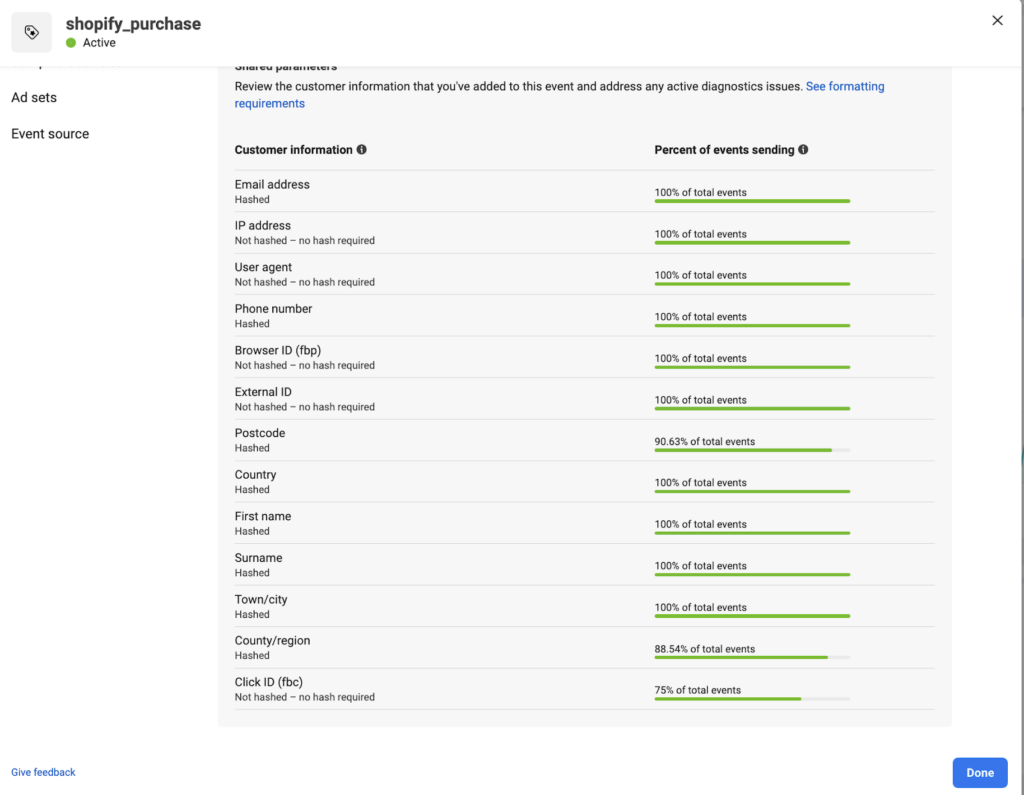
Here, you can see how Meta is calculating the percentage of events matched.
To check your Event Match Quality score for all the events you send to Meta, navigate to all tools > events manager > find the event score against any of the events and click on the score. It pops up all the parameters you are sending along with that event for the users in it, and how well Meta is able to match the users with your events by showing a percentage.
How do we effectively send these parameters along with event data?
Now, getting down to the actual work of sending the event parameters to Meta, there are some solid approaches you must follow.
Setup Conversions API and Meta Pixel
The customer information parameters side by side with event data can be passed on to Meta using two tools.
One, Meta’s Conversions API (CAPI)
It helps marketers send the parameters and events from their websites, apps, or servers on the server side so that no privacy rules are violated. It forms a direct connection between an advertiser’s marketing data and Meta and allows businesses to send various types of data such as website events, app events, and even offline conversions. This data can be sent from their servers, website platforms, mobile apps, or CRM systems to Meta via server-side to improve the Event Match Quality score. Since the data are sent via the server side it reduces the risk of signal loss caused by ad blockers and browser limitations.
Two, Meta Pixel
This is the tool that sends events from the browser side to Meta. It is a piece of code placed on the website or a landing page, that tracks user interactions and sends event data back to Meta. Make sure to have Meta pixel installed across all the web pages so that as much data as possible can be collected and sent to Meta for better event matching.
Activate advanced matching for Web
Meta pixel has a beautiful feature called advanced matching. It finds the fields in the website that collect information like name, email address, mobile number, and other event parameters, captures this information directly from the website, and sends it to Meta. You can leverage advanced matching for web easily to sync event parameters with Meta and increase the EMQ score.
There are two ways to set up advanced matching
One, Automatic
To set up automatic advanced matching, go to Event Manager> data sources > pick the pixel for which you need to allow automatic advanced matching.
Then, go to settings, locate “automatic advanced matching” and switch the toggle on.
Now, enable the customer information parameters that you want to send by flicking the toggles on for each of the customer parameters – Email; Phone number; First and last name; Gender; City, State, ZIP/Postal Code; Country; Date of birth; and External id.
Read this blog to know who can and who can’t use automatic advanced matching and more.

Two, Manual
Activating advanced matching manually is a task, I’d suggest you get help from a developer. You also must have access to your website code to set up advanced matching manually.
The first thing you have to do is, to insert the pixel fbq function call as a parameter in your website code. Then, push the visitor data and the parameters as a JSON to Meta.
Now, simply replace the Pixel ID with your Pixel ID in the below code.
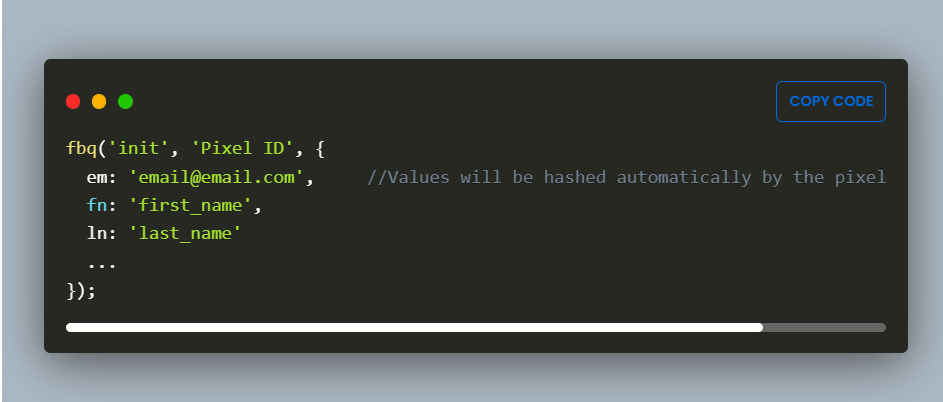
In case you are already hashing the user information with SHA-256, you can use the IMG tag to move these values to Meta. For sending the user data hashed using the <img> tag, refer to the below example.
All you have to do is change the PIXEL ID to your pixel ID in the below code.
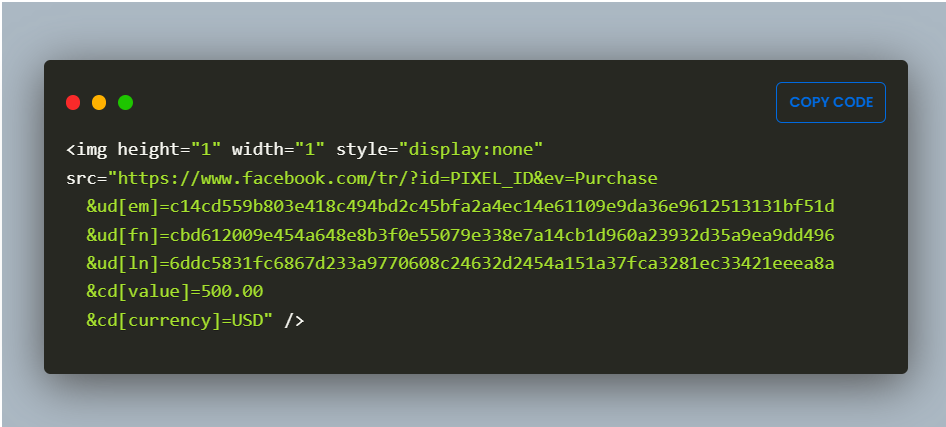
Sync all the event parameters
Make sure all the customer data parameters for an event available are synced with Meta. Install Meta pixel across all the webpages, set up Conversions API, make use of advanced matching in Meta-pixel, and use all the other ways to send any available data. This matters because Meta needs as many event parameters as possible to match with the Meta accounts.
CustomerLabs 1PD Ops is a great option to sync all the data to Meta. It helps you gather data from different sources like your website, your offline store, and CRM and combines it into one single 360-degree profile for a user. This profile unifies all the event parameters the business has, of a user, across systems. So that, you can seamlessly send a number of event data to Meta with just one click. Therefore, with all these customer parameters, you can help increase your EMQ score!

How can you increase Meta Ads event match quality?
Everything I’ve discussed so far boils down to one thing, that is, improving the event match quality. We already know that EMQ can be increased by sending valid parameters to Meta and how to send it. Now, let me walk you through some of the best practices for improving Meta Ads Event Match Quality or keeping your existing EMQs intact.
The top tricks to increase your EMQ scores or keep up the EMQ scores are right here:
- Use the integration of pixel with Manual Advanced Matching + Conversions API to send as many event parameters as possible to Meta.
- The use of properly set-up Conversions API and pixel for sending event data reduces signal loss.
- Connect more than one pixel to increase the Event Match Quality. By using more pixels you can sync more events and optimize the ad campaigns with the data collected.
- Keep an eye on Conversions API occasionally to make sure the setup is proper and all the event data is synced into the Meta Ad platform without any data loss.
Low Event Match Quality = Low Ad Campaign Performance?
Do not think your events should have all the parameters, and have a high Event Match Quality score always. In scenarios where you have a business that attracts less traffic from Meta Ads, and most of them like always are anonymous website visitors, you will not have either the email address or the fbclid / fbc / fb click ID. Now, when these two parameters that have high priority aren’t available, how will you be able to achieve a higher EMQ score? You cannot. Does that mean you cannot run good-performing ad campaigns?
No, the only point is, just to capture as many parameters of the users as you can, and sync it with Meta. For example, you can capture and sync even for anonymous users the IP address, external ID, etc.
And, the maximum EMQ we have seen so far is 9.3 for a purchase event where almost all the parameters match 100%, except fbc and a few others.
Therefore, follow the best practices, use the best tools, and sync as many customer parameters you have for your events to Meta.
What is poor, ok, good, and great in EMQ?
It is the grading that Meta Ads gives by comparing your event data with similar advertisers in your region.
To calculate the Event Match Quality score, Meta assigns a score out of 10, considering how well the event parameters sent are matched with the data in the Meta account center.
Then your event match quality score is compared to other advertisers in your region who are sending similar events. By this comparison, Meta will categorize your performance as ‘Poor’, ‘Ok’, ‘Good’, or ‘Great’.
So, even having an EMQ of 7 might show an ok rating, and an EMQ of 6 might show a good rating.
And, Meta recommends a grade of ‘Good’ or ‘Great’ for an improved ad campaign performance.
To conclude
Meta has time and again said that it matches users using the event parameters that are sent to Meta. To calm the confusion of which event parameters to send, it has also given the list of parameters based on priority in the palm of our hand.
The one simple thing for you to do is send any available data to Meta following the best practices and see the Event Match Quality score soar like a shooting star.
To know more on how to boost your event match quality score by following the best practices, talk to our experts.

